2023.08.03.109
Files > Volume 8 > Vol 8 No 3 2023
Diversity of Freshwater Fishes in Iraq
1Iraq Natural History Research Center &Museum \ University of Baghdad/Iraq.
2 College of Science /Baghdad University / Iraq.
3Department of Fisheries and Marine Resources, College of Agriculture, University of Basrah/ Iraq. [email protected].
*Correspondence: e-mail: [email protected]
Available from: http://dx.doi.org/10.21931/RB/2023.08.03.109
ABSTRACT
Many studies have focused on identifying and classifying freshwater fishes in Iraq, concerned with describing, organizing, and drawing up a list of freshwater fishes in Iraq or the Tigris and Euphrates rivers. Within the most recent updates at the beginning of 2023, 53 native freshwater and 20 exotic (alien or introduced) fish species are recorded and described. This study reviewed the database of morphology and molecular studies of freshwater fish in Iraq and reported species while surveying the fish fauna at different water bodies of the country from 2010 to the beginning of 2023. In conclusion, 29 species (about 40.3%) of all 72 fish species in Iraq still need to be available information on their molecular data.
Keywords: alien, endemic, freshwater, morphometric features, taxonomic, Tigris.
INTRODUCTION
Fishes are an enormous group of aquatic vertebrates and have traditionally been estimated as an indicator of water quality and a source of protein for human utilization. Fishes show the most significant biodiversity of the vertebrates (animals with backbones), and they are generally distributed in two large environments: the salty marine water environment, in which the percentage of fishes is about 57%, and the freshwater environment, with 43% of the whole number of fishes around the world 1. The search for Iraqi fish wealth dates back to the time of Babylon, Sumer, and Assyria 2. Ancient Mesopotamians identified and named numerous marine and freshwater species recorded on clay tablets 3. The real taxonomical works in Iraq started in the 19th century when Heckel 4 described 17 freshwater fish species from the Tigris River at Mosul city, northern Iraq. Past to that date, the works of Hasselquit (1722-1752) and Russell (1742-1753) on diverse parts of the Middle East were considered the early works on fish scientific classification in this portion of the world. The authors of these works did not collect the materials from Iraqi waters despite the reality that the species they described were displayed in Iraq. Afterward, in this way, they are considered out of their research scope 5. The present study aimed to review the fish fauna of Iraq from the taxonomical point of view, in both morphological and molecular approaches, based on published works that recorded species from Iraqi waters during the last 12 years.
Diversity of freshwater fishes in Iraq
The present study covers the studies on freshwater fish species of Iraq after 2010 due to the most fish species before this period have been reviewed and prepared lists of each fish group 6, As well as the history of the fish fauna (Freshwater and marine) of Iraq during 19th, 20th and 21st centuries were pointed and reviewed until 7. Based on morphometric and meristic characteristics, the Cobitis linea was recorded in Huweza marsh, southern Iraq 8. At Al-Rathwania Lake, western Baghdad, 18 species of fish were recorded belonging to six families (Cyprindae, Bagridae, Mugilidae, Heteropneustidae, Mastacembelidae, and Siluridae) 9. A total of 53 fish species, including 51 species belonging to bony fishes and two species to Chondrichthyes, were recorded from Shatt Al-Basrah, canal southern Iraq 10. At Um Alnaaj, Al-Hawizah marsh, east of the Tigris River in southern Iraq, 13 species of fish were recorded belonging to six families (Cyprinidae, Mugilidae, Siluridae, Heteropneustidae, Mastacembelidae, and Bagridae) 11. A total of 27 species of fish belonging to five families (Cyprinidae, Mugilidae, Heteropneustidae, Sisoridae, and Mastacembelidae) were recorded from Dukan Lake 12. While 20 species of fish were identified belonging to six families (Cyprindae, Bagridae, Siluridae, Mugilidae, Mastacembelidae and Cichilidae), including Liza abu (=Planiliza abu), Carassius auratus, and Carasobarbus luteus most abundant species from the Euphrates River at Al-Hindia city south of Baghdad, Iraq 13. From Al-Chybayish marsh, 14 fish species were identified and reported; Liza abu (=Planiliza abu) was the most abundant species 14. Forty species of fish were recorded belonging to 19 families (Cyprinidae, Sciaenidae, Mugilidae, Clupeidae, and Gobiidae families from freshwater) in the Shatt Al-Arab River, Carassius auratus was the most abundant species, followed by anadromous shad Tenualosa Elisha and Liza abu (=Planiliza abu) 15. Tooth carp fishes Aphanius dispar (=A. stoliczkanus), A. mento (Paraphanius mento), Poecilia latipinna, and Gambusia hollbrook were described using morphometric and meristic characteristics from Hammar Marsh, southern Iraq 16. In Darbandikhan Lake, 17 species of fish were identified belong to four families (Cyprinidae, Bagridae, Siluridae, and Mastacembelidae) 17. Carassius auratus auratus was recorded within Basrah freshwater systems based on morphometric and meristic characteristics 18. The exotic Oreochromis niloticus was recorded for the first time in Iraq from the Shatt Al-Arab River 19. Tigris catfish Silurus triostegus was redescribed by using 13 morphometric characters from three localities within Tigris and Shatt al-Arab Rivers 20. From the southern marshes of Thiqar Province, southern Iraq Day’s goby Acentrogobius dayi was recorded for first time 21. Brond-snout Chondrostoma regium was recorded for the first time from the Shatt Al-Arab River by studing 25 morphometric and 16 meristic characters to describe the species 22. From East Hammar Marsh southern Iraq, identified 47 species of fishes belong to 35 genera and 20 families, including 23 marine and 24 freshwater species, Liza abu (=Planiliza abu) and Carassius auratus were the most abundant species 23. Two new species of Oxynoemacheilus Banarescu & Nalbant, 1966 (O. gyndes and O. hanae) were reported from the Sirwan River, Tigris River, northern Iraq 24. Carasobarbus sublimus was reported for the first time in Iraq from Shatt al-Arab River, south of Qurna city 25. Based on morphometric and meristic parameters, 27 species of fish were recorded from Greater Zab River, Aski-kalak, west of Erbil city, northern Iraq; the most fish species recorded were native species, except five species were exotic, including C. carpio, C. auratus, and Ctenopharyngodon idella, Heteropneustes fossilis, and Caspian trout Salmo campus. Caspian trout was recorded for the first time in Iraq 26. The taxonomic status of five nominal species of cyprinid fishes, Alburnus populations were described based on morphometric and meristic characters from the Middle East and explained the Alburnus mossulensis was a synonym of Alburnus sellal 27. Single specimen of alligator gar, Atractosteus spatula belonging to Lepisosteidae was recorded for the first time in the Shatt al-Arab River, Basrah, Iraq 28. Depending on the morphometric and meristic parameters and electrophoretic analysis of lateral muscle proteins, Planiliza abu has been recorded in Qarmat Ali River, north Basrah, Iraq 29. The status of the fish assemblage structure of Al-Huwaizah marsh and abundance were described to compare the fish assemblage in this marsh before a decade 30. Twenty-four species of fishes were recorded belonging to 10 families, including 17 native species and seven alien species; the most abundant species were blue tilapia Oreochromis aureus, which accounted 26.84% of the overall capture in a north station in the Euphrates River in Al- Samawa city southern Iraq, the most abundant species in the south station was Prussian carp Carassius auratus 31. From the Great Zab River, northern Iraq 11 species of fish Garra rufa, Chondrostoma regium, Luciobarbus xanthopterus, Barbus barbulus (=Luciobarbus barbulus), Barbus belayewi (=Capoeta damascina), Barbus grypus (=Arabibarbus grypus), Cypinion kais, Capoeta trutta, Mastacembelus mastacembelus, Carassius carassius, and Liza abu (=Planliza abu) were described 32. Twelve freshwater fish species belonging to the family Cyprinidae were recorded from different water bodies of Halabja province, northeast of Iraq 33. The biodiversity of fishes belonging to eight families and 35 species were studied from the Lesser Zab, and Sirwan within Sulaimani province, Iraq, and Cyprinion macrostomum was the more abundant and widespread species in the area, while Leuciscus vorax was rare 34. Capoeta trutta from Dukan Lake and Liza abu (=Planliza abu) from Sirwan River, northwestern and southeastern Sulaimani province, Iraq were recorded 35. An updated checklist of the freshwater fishes of Iraq was reviewed and represented with 50 native and 16 exotic fish species counted 36. Wels catfish Silurus glanis was a confirmed recorded from the Chibayish marsh area, southern Iraq, and made a comparison with Tigris catfish S. triostegus 37. A single specimen, Danube sturgeon Acipenser gueldenstaedtii, was recorded for the first time from the Euphrates River, western Iraq 38. The freshwater fish diversity, abundance, ecological indices, and water quality were reported from the main outfall drain in Al- Diwaniya city, middle Iraq 39. The fishes of the Euphrates and Tigris Rivers basin were reviewed, and identified 52 fish species in Iraq 40. Glyptothorax kurdistanicus, G. cous, and G. daemon were recognized from Euphrates and Tigris drainages, one of which (G. daemon) was described as a new species41. Cyprinion carpio, Tenualosa ilisha, and Clarias gariepinus from Little Zab river, in Tikrit province, northern Iraq were recorded42. A single specimen of Oscar, Astronotus ocellatus, was described for the first time from the Euphrates River in Babylon Province in central Iraq 43. The morphology of pharyngeal bones and teeth in seven cyprinid species were studied in the Greater Zab River, Kurdistan province, northern Iraq 44. From the Euphrates River in Karbala province, 27 species belonging to 11 families and six orders 45 were recorded. A single Caspian trout Salmo caspius specimen was reported at Shatt Al-Arab, Basrah, southern Iraq 46. The Amazon sailfin catfish, Pterygoplichthys pardalis, belonging to Loricariidae, was recorded for the first time in the Shatt al-Arab River, Basrah, Iraq 47. Table (1) summarizes the current morphological studies between 2010 the end of 2022.
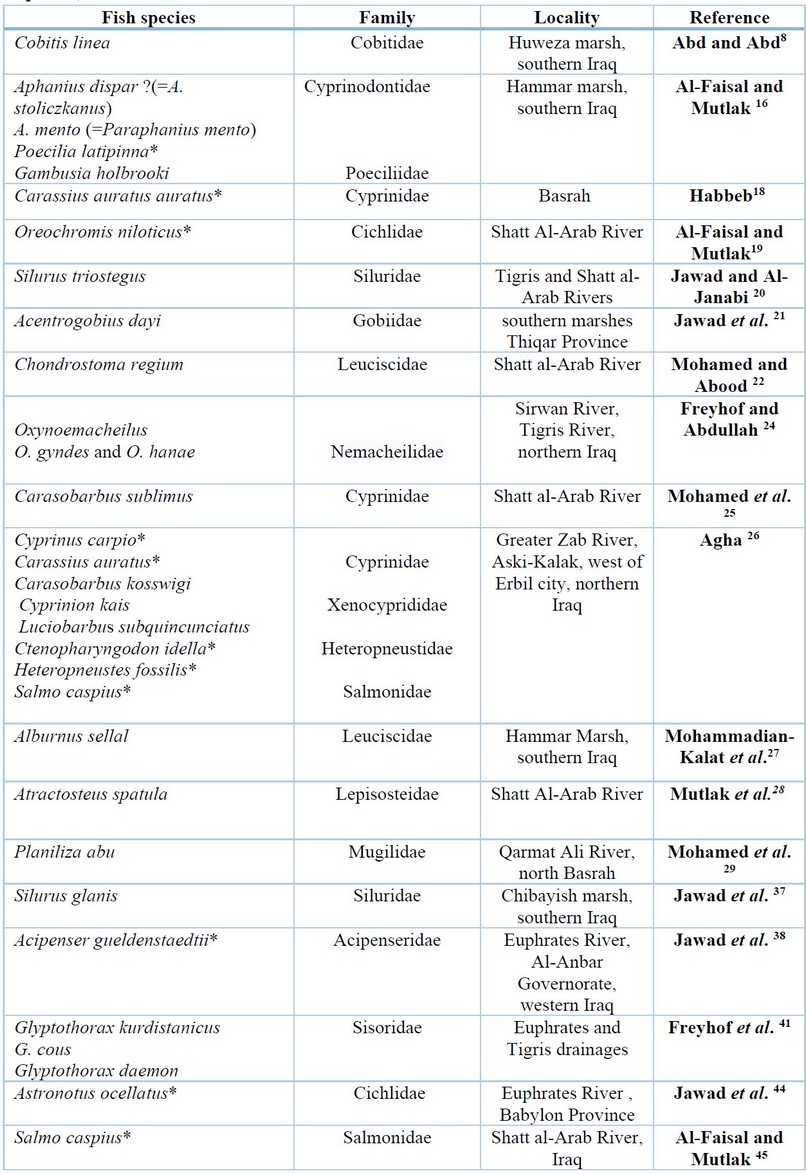
Table 1. Morphometric and meristic studies of some freshwater fish species in Iraq (* Exotic species)
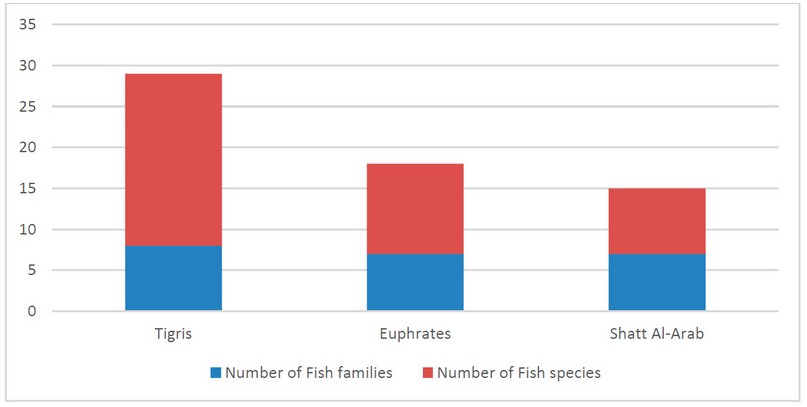
Figure 1. Number of fish families and number of fish species in taxonomical studies in each main river in Iraq.
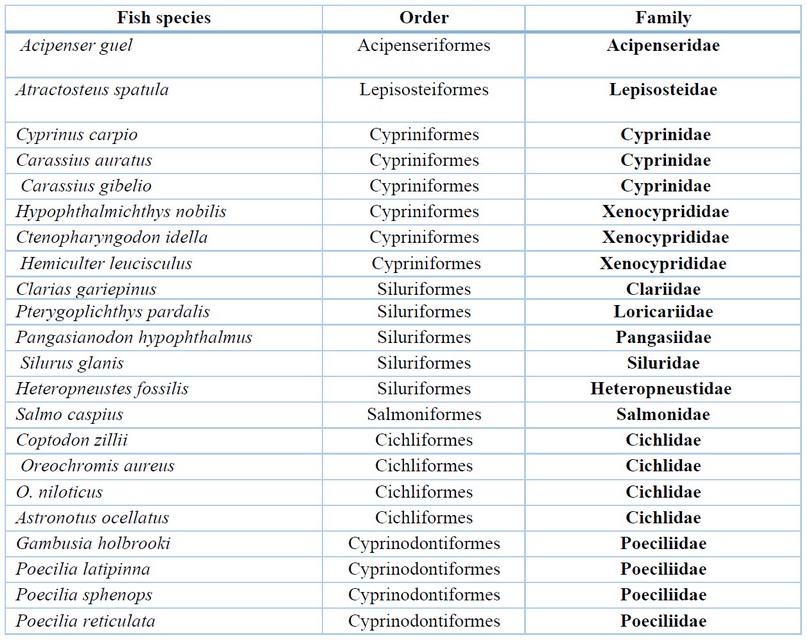
Table 2. The exotic fish species in Iraq.
Molecular study of freshwater fishes
Fishes show a spectacular diversity of sizes, shapes, and colors; the delimitation and identification of fish species are not only crucial for scientific classification and systematics, but it is additionally a requirement in studies of fishery management, normal history, and biology, following the dispersal styles of eggs and larvae, estimations of staffing and spawn areas, and food product authentication 48. Fish identity is historically based on morphological features. However, because of excessive variety and morphological plasticity, fish and their diverse developmental stages are difficult to identify by using morphological characteristics alone 49. Deoxyribonucleic acid (DNA) based identification techniques have been advanced and proved to be analytically 50. As a standardized and familiar method, DNA barcoding identification systems have been widely advocated to identify species and broadly biological diversity in recent years 51. Researchers have started to apply new technologies primarily based on the polymerase chain reaction (PCR) method, such as recombinant DNA and polymorphic DNA markers and DNA sequence information to resolve fish taxonomy, phylogeny, population, and genetic and evolutionary biology questions 52. Geometric morphometric and molecular techniques have become major equipment for systematic ichthyologists and fish biologists to ratify taxonomic problems at species and population levels 53.
Molecular study of freshwater fishes in Iraq
The first molecular study of Iraqi fish started when used the DNA fingerprints to identify eight cyprind fish species Luciobarbus kersin, Barbus barbulus (=Luciobarbus barbulus), B. grypus (=Arabibarbus grypus), B. sharpeyi (=Mesopotamichthys sharpeyi), B. luteus (=Carasobarbus luteus), B. xanthopterus (Luciobarbus xanthopterus), Aspius vorax (=Leuciscus vorax), and Cyprinus carpio in Iraqi waters using RAPD-PCR method with seven decamere primers 52. Mitochondrial 16S rRNA gene was employed to identify cyprind fish species B. xanthopterus (L. xanthopterus), B. kersin, (=Luciobarbus kersin), B. barbulus (=L. barbulus), B. grypus (=A. grypus), B. sharpeyi (=M. sharpeyi), B. luteus (=C. luteus), and C. carpio in Shatt Al-Arab River 54. Barbus barbulus (=L. barbulus), B. grypus (=A. grypus), B. sharpeyi (=M. sharpeyi), B. luteus (=C. luteus), B. xanthopterus (L. xanthopterus), B. kersin, (=L. kersin) were identified using PCR-RAPD in Iraqi freshwater fishes 55. The molecular diversity for nine species of Cyprinidae was described Barbus grypus (=A. grypus), Carasobarbus luteus, Carassius carassius, Chondrostoma regium, Capoeta trutta, C. carpio, Cyprinion macrostomum, Luciobarbus esocinus, and L. xanthopterus in Dukan Lake, Kurdistan Region Based on morphological and DNA barcode 56. The genetic diversity of L. xanthopterus was recorded in four habitats in Iraq; Shatt Al-Arab River, Dokan reservoir, Kut city, and Kerbala'a, using the RAPD technique 57. The mitochondrial (COI) and nuclear molecular markers (Rhodopsin) were employed to redescribe Garra elegans from the lower Tigris River in Iraq 58. The new species Eidiuemacheilus proudlovei was described from subterranean waters in the Little Zab River in northern Iraq using DNA barcode 59. The RAPD-DNA markers were used to study genetic diversity between the different common carp populations from Dukan and Darbandikhan Lakes in Sulaimani province, northern Iraq 60. Carassius auratus, L. kersin, and S. triostegus were identified within Greater Zab River, northern Iraq by using the PCR-sequencing method 26. The molecular genetic status of Aphanius stoliczkanus was redescribed from Arabian Gulf region using mitochondrial DNA COI gene 61. The taxonomic status of five nominal species of cyprinid fishes was studied from the Middle East by applying morphological and molecular (COI) characters. The Alburnus mossulensis was explained as a synonym of Alburnus sellal 27. The mitochondrial DNA cytochrome c oxidase subunit I (mtDNA COI) locus 625 bp and 61 cytochrome b (cytb) gene 521 bp was used to identified two fishes Capoeta trutta, and L. abu (=Planiliza abu) in Sulaimani province, northern Iraq 62. Based on using RAPD markers two tilapia species Coptodon zillii, and Oreochromis aureus was recognized from the Euphrates River at Governorate of Al-Muthanna 63. By using morphological and molecular characters studies, the family Aphaniidae reviewed and recognized eight genera, including two new genera Esmaeilius and Apricaphanius; Aphanius mesopotamicus and A. sophiae transferred to genus Esmaeilius and the latter species considered valid, while A. mesopotamicus treated as synonym of E. sophiae 64. Three species of tilapia, Coptodon zillii, O. aureu, and O. niloticus were examined using randomly amplified polymorphic DNA (RAPD) from the Shatt Al-Arab River 65. The cytochrome c oxidase subunit I (COI) gene was used to study genetic structure of Carasobarbus kosswigi, C. trutta, C. macrostomum, L. barbulus, Garra rufa, Acanthobrama marmid, Alburnus mossulensis, Chondrostoma kinzelbachi, Leuciscus vorax, Squalius cephalus, Arabibarbus grypus, Carasobarbus luteus, and Capoeta damascina from Greater Zab River, Iraq 66. Glyptothorax kurdistanicus, G. cous, and G. daemon were recognized using mitochondrial DNA COI gene from Euphrates and Tigris drainages, G. daemon is described as new species 41. The evaluation of the genotype of Barbus luteus (=C. luteus) was studied from the governorates of Basrah and Dhi Qar, based on the ISSR-PCR Technique 67. The mtDNA cytochrome-b gene was used as a molecular marker for detecting genetic diversity, origin, and divergence of the Hilsa shad Tenualosa ilisha population within the Shatt Al-Arab River 68. The genetic structure of three Capoeta species (C. trutta, C. damascina, and C. umbla) were studied using the mitochondrial cytochrome oxidase I (COI) gene in the Greater Zab River of the Kurdistan Region- Iraq 69.
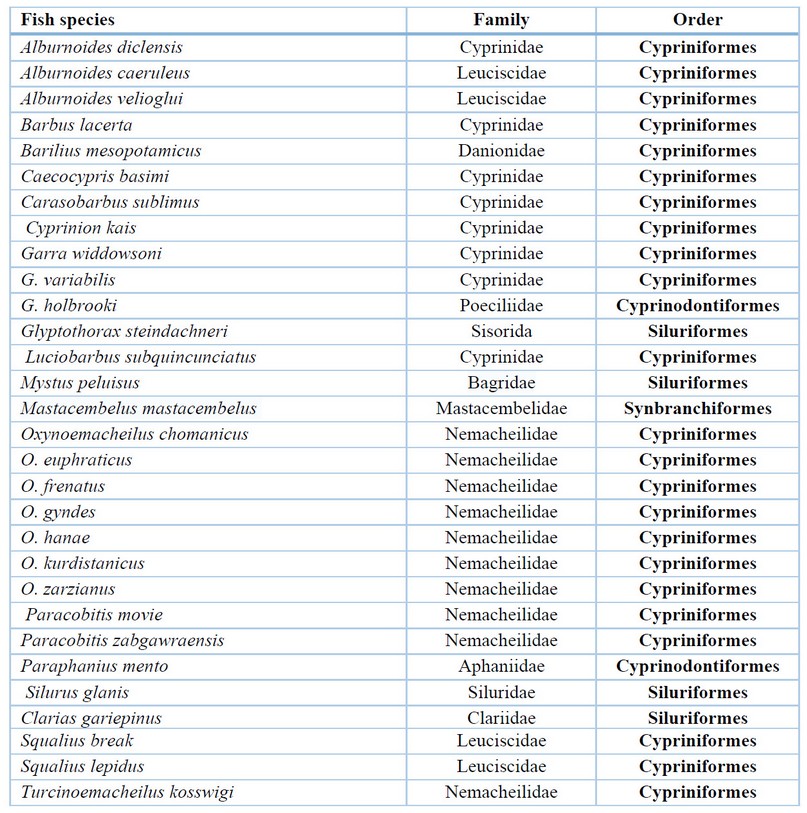
Table 3. The fish species that have not been studied genetically yet in Iraq.
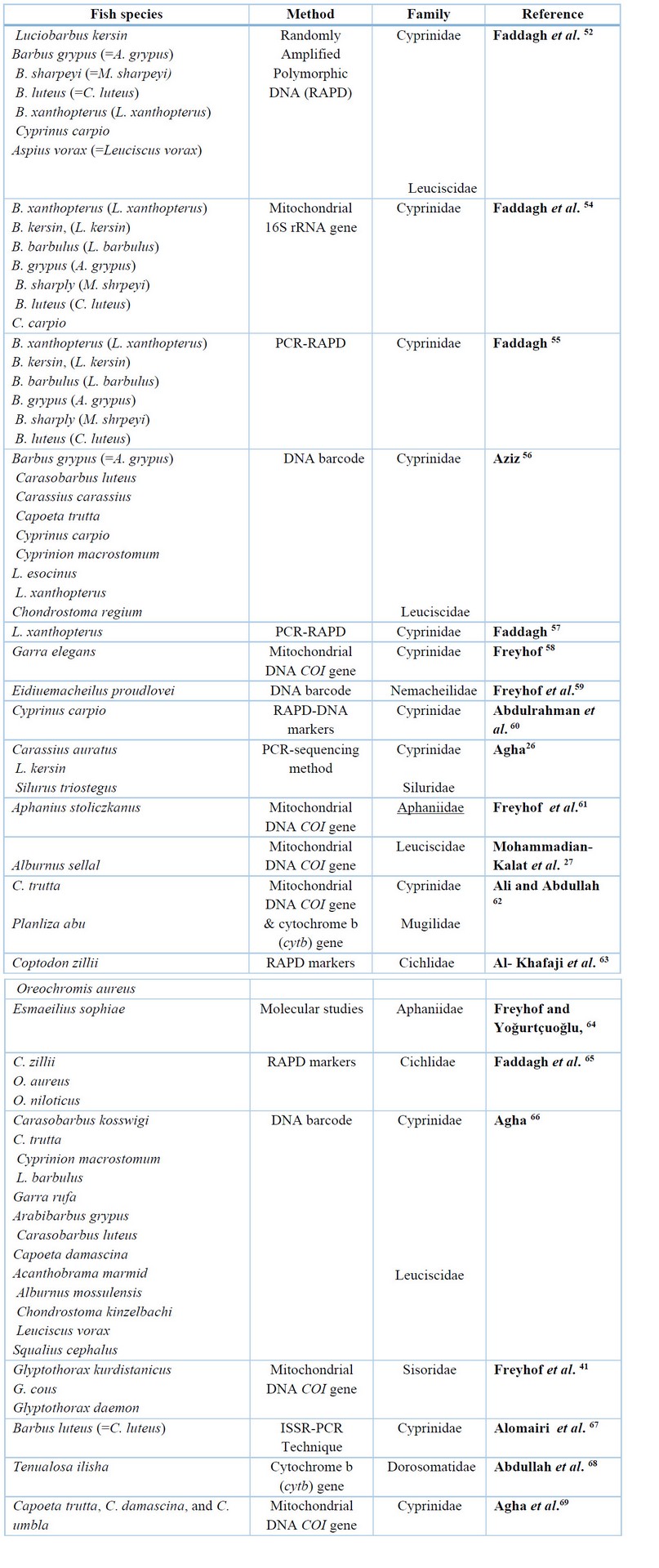
Table 4. Molecular studies of some freshwater fish species in Iraq.
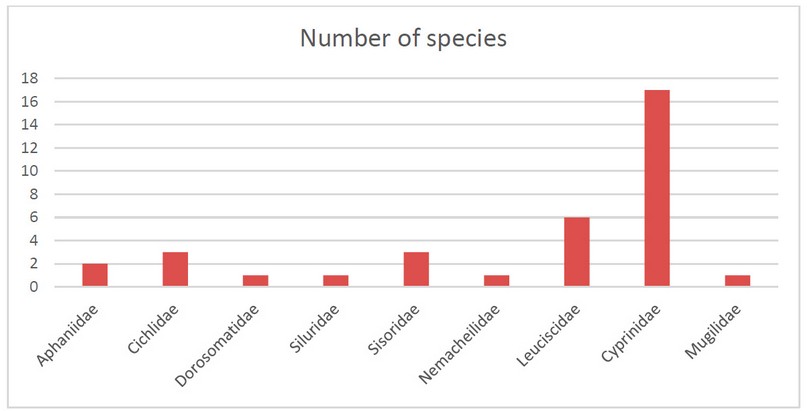
Figure 2. Number of species in each fish family in molecular taxonomical studies in Iraq.
CONCLUSION
The current study reviewed freshwater fishes in Iraq and is an essential reference for all researchers and authors who plan to study this field more comprehensively. Our study revealed that in the 12 years, incredibly alien fish fauna was introduced and recorded, and the generic or familiar status of some native fishes has been revised. A total of 53 native freshwater species belonging to 18 families and eight orders, in addition to 20 exotic (alien and introduced) fishes belonging to 13 families and eight orders, were recorded in Iraq until the beginning of 2023. This research will be the keystone for other studies in various taxonomic, parasitological and ecological fields, and it will facilitate others to obtain these sources that were scattered in several journals and also help them to study other aspects that were not previously studied, such as selecting new genes that were not studied on Iraqi fish.
Conflicts of Interest: "The authors declare no conflict of interest."
REFERENCES
1. Nelson, J.S., Grande, T.C. and Wilson, M.V.H. Fishes of the World; 5th Edition, John Wiley and Sons, Hoboken. 2016, ISBN 978-1-118-34233-6.
2. Saggs, H.W.F. The greatness that was Babylon. Sidgwick and Jackson, London. 1962, 562pp.
3. Landsberger, B. The fauna of ancient Mesopotamia. MSL VIII/2, second part. Pontificium Institutum Biblicum, Roma 204, Piazza Pilotta 35. Publié avec le concourse financier de l'UNESCO et sous less auspices du Conseil International de la Philosophie et des Sciences Humaines. 1962, 180pp.
4. Heckel, J.J. Abbildungen und Beschreibungen der Fische Syriens nebst einer neuen Classification und Characteristik sämmtlicher Gattungen der Cyprinen. Stuttgart 1843, 109 pp.
5. Coad, B.W. Freshwater fishes of Iraq. Pensoft Series Faunistica 2010, ISBN 978-954-642-530-0.
6. Al-Faisal, A.J. Check of the taxonomy of freshwater fishes of Iraq. Iraqi Journal of Aquaculture. 2010, 7:101 -114. (In Arabic).
7. Jawad, L.A. History of the study of the fish fauna of Iraq. Water Research and Management. 2012, 2:11-20.
8. Abd, I.M. and Abed, J.M. First Record of Cobitis linea (Heckel, 1849) in Huweza Marsh, Southern Iraq. Marsh Bulletin. 2010, 5:170-176.
9. Al- Rudainy, A.J. Ecology and nature of fish structure in Al- Rathwania Lake, West of Baghdad. Iraq Academic Scientific Journals. 2010, 15:1-11. (In Arabic).
10. Younis, K.H. and Al-Shamary, A.CH. Species composition of fishes assemblage in Shatt Al-Basrah Canal, South of Iraq. Iraqi Journal of Aquaculture. 2011, 8:137-156.
11. Younis, K.H., Al-Mossawy, M.H. and Jabi, A.A. Composition structure of fish assemblage in Um Alnaaj, Al-Hawaizah Marsh, Iraq. Journal of Basrah Researches Sciences. 2011, 37:49-59.
12. Abbas, L.M. and Sediq, S.O. Some biological indexes of fish community at Dukan Lake, North of Iraq. Basrah Journal of Agricultural Science. 2012, 25:228-241. (In Arabic).
13. Al- Amari, M.J. and Taee, M.M. Study of fishes community and ecological indices in Euphrates River at al-Hindia city, Iraq. Journal of Babylon University/Pure and Applied Sciences 2012, 20:1523-1535.
14.Mohamed, A.R.M., Hussain, N.A., Al-Noor, S.S., Mutlak, F.M., Al-Sudani, I.M. and Mojer, A.M. Ecological and biological aspects of fish assemblage in the Chybayish marsh, Southern Iraq'. Ecohydrology Hydrobiology. 2012a, 12:65-74.
15. Mohamed, A.R.M., Resen, A.K. and Taher, M.M. Longitudinal patterns of fish community structure in the Shatt Al-Arab River, Iraq. Basrah Journal of Science. 2012b, 30:65-86.
16. Al- Faisal, A.J. and Mutlak, F.M. Identification of cypriniodontiformes fishes from Al- Hummar Marsh, south of Iraq. Proceeding of the 4th Kurdistan conference on Biological Sciences, University of Duhok 8-10 May, 2012.
17. Abdullah, Y.S. Study on the Parasites of some Fishes from Darbandikhan Lake in Kurdistan Region, Iraq. M. Sc. Thesis, Collage of Science Biology University of Sulaimani, 2013, 116pp.
18. Habbeb, F.Sh. Biometric characteristics of the common goldfish Carassius auratus auratus (Linnaeus, 1758) in Basra freshwater systems. Mesopotamian Journal of Marine Science. 2014, 29:155 - 161.
· 19. AL- Faisal, A. J. and Mutlak, F. M. (2014). First record of the Nile tilapia Oreochromis niloticus (Linnaeus, 1758), from the Shatt Al-Arab River, Southern Iraq. Mesopotamian Journal of Marine Science , 29(1): 45-50.
20. Jawad, L.A. and Al-Janabi, M.I.G. Morphometric characteristics of the catfish Silurus triostegus Heckel, 1843 from the Tigris and Shatt Al-Arab Rivers, Iraq. Croatian Journal of Fisheries. 2016, 74:153-165.
21. Jawad, L.A., Nasir, N.A., Al-Faisal, A.J., Sultan, Q.M. and Mahlhal, M.S. Day’s Goby, Acentrogobius dayi Koumans, 1941 (Pisces: Gobiidae) in the southern marshes, Thiqar, Southwest Baghdad, Iraq. International Journal of Marine Science. 2016, 6:1-5.
22. Mohamed, A.R.M. and Abood, A.N. Occurrence of the King Nase, Chondrostoma regium (Heckel, 1843) in the Shatt Al-Arab River, Iraq. Journal of Agriculture and Veterinary Science. 2016, 9:85-89.
23.Mohamed, A.R.M., Hussein, S.A. and Mutlak, F.M. Stock assessment of four fish species in the East Hammar Marsh, Iraq. Asian Journal of Applied Sciences. 2016, 4:620- 627.
24. Freyhof, J. and Abdullah, Y.S. Two new species of Oxynoemacheilus from the Tigris Drainage in Iraqi Kurdistan (Teleostei: Nemacheilidae). Zootaxa. 2016, 4238:073-087.
25. Mohamed, A.R.M., Abood, A.N. and Jawad, L.A. Presence of Carasobarbus sublimus (Coad & Najafpour, 1997) in the upper reaches of Shatt Al-Arab River, Basrah, Iraq. Zoology and Ecology. 2017, 27:30-34.
26. Agha, G.F. Morphological and molecular identification of some inhabitant fishes in greater Zab River/Aski-Kalak in Kurdistan Region, Iraq. M. Sc. Thesis, College of Agriculture, University of Salahaddin, 2017, 138pp.
27. Mohammadian- Kalat, T., Esmaeili, H.R., Mansour Aliabadian, M. and Freyhof, J. Re-description of Alburnus doriae, with comments on the taxonomic status of A. amirkabiri, A. mossulensis, A. sellal and Petroleuciscus esfahani (Teleostei: Cyprinidae). Zootaxa. 2017, 4323:487-502.
28. Mutlak, F., Jawad, L. and Al-Faisal, A. Atractosteus spatula (Actinopterygii: Lepisosteiformes: Lepisosteidae): A deliberate aquarium trade introduction incidence in the Shatt Al-Arab River, Basrah, Iraq. Acta Ichthyologica Et Piscatoria. 2017, 47:205-207.
29. Mohamed, A.M., Abood, A.N. and Hussein, SA. Taxonomical study of Planiliza abu in Qarmat Ali River, Iraq. Scientific Journal of King Faisal University, Basic and Applied Sciences. 2018, 19:11-20.
30. Al- Thahaibawi, B.M.H., Younis, K.H. and Al-Mayaly, I.A. Fish assemblage structure in Al-Huwaizah marsh southern of Iraq after inscribed on the World Heritage List. Iraqi Journal of Science. 2019, 60:1430-1441.
31. Al- Helli, AM. S., Resen, A. K. and Ali, A. H. Fish assemblage in the Euphrates River at Al-Samawa city, southern Iraq. Basrah Journal of Agricultural Science. 2019, 32:33-46.
32. Mizory, F.A. and Abdulrahman, N.M. Survey and ichthyofauna of Great Zab River in Deralok hydropower plant. Journal of University of Duhok. 2019, 22:69-79.
33.Al- Moussawi, A.A. and Afrasiab, S.R. A small collection of cyprinid fishes of fountain and natural streams of Halabja city, north east of Iraq. Advances in Bioresearch. 2019, 10(2):33-39.
34.Abdullah, Y.S., Abdullah, S.A. and Hussein, R. H. Biodiversity of Fishes in Sulaimani Province in Kurdistan Region, Iraq. Zanco Journal of Pure and Applied Sciences. 2020, 32:39-44.
35. Ali, K.M. Morphological and moleculary studies on the genus Neoechinorhynchus Stiles and Hassall, 1905 from two freshwater fishes In Sulaimani Province. Ph. D. Thesis, College of Agricultural Engineering Sciences, University of Sulaimani, 2020, 137pp.
36. Al-Faisal, A.J. Updating checklist of freshwater fishes of Iraq. Mesopotamia Environmental Journal 2020, 5, 1-7.
37. Jawad, L.A., Abed, J., Mohsen, Z. and Al-Janabi, M.A. Confirmed record of the European catfish Silurus glanis L., 1758 (Actinopterygii: Siluriformes: Siluridae) from the southern marshes of Iraq, with a new anatomical set of characters to separate S. glanis and S. triostegus. Integrative Systematics. 2021a, 3:85-100.
38. Jawad, L.A., Al-Sheikhly, O.F. and Al-Dirawi, A.M.H. The Danube sturgeon Acipenser gueldenstaedtii Brandt & Ratzeburg, 1833 (Actinopterygii, Acipenseridae) in the Euphrates River, Iraq. Acta Scientiarum Polonorum Zootechnica. 2021b, 20:33-38.
39. Al- Zaidy, K. J.L. Water Quality and Conservation Status of Fish Fauna of Main Outfall Drain, Al-Diwaniya City, Iraq. Earth and Environmental Science. 2021, 910:1-6.
40. Freyhof, J., Kaya, C. and Ali, A. Chapter 35: A critical checklist of the inland fishes native to the Euphrates and Tigris. Pp: 815-855. In Jawad, L. A. (Ed.). Tigris and Euphrates Rivers: Their Environment from Headwaters to Mouth Drainages; Springer: Cham 2021a; 1640pp. https://doi.org/10.1007/978-3-030-57570-0_35
41. Freyhof, J., Kaya, C., Abdullah, Y.S. and Geiger, M.F. The Glyptothorax catfishes of the Euphrates and Tigris with the description of a new species (Teleostei: Sisoridae). Zootaxa. 2021b, 4969:453-491.
42. Mohammed, E.H. The affection of environmental conditions of Three types of fish with external parasites of the Little Zab river. M. Sc. Thesis, College of Education for Girls, University of Tikrit, 2021, 99pp.
43. Jawad, L.A., Agha, G.F., Abdullah, S.M.A., Aguilar, G. and Qasim, A.M. Morphology and morphometry of pharyngeal bone and teeth in cyprinid species from the Kurdistan region, Iraq. The Anatomical Record 2022a, https://doi.org/10.1002/ar.24906
44. Jawad, L.A., Al-Sheikhly, O.F. and Al-Fayadhi, K.H. The Oscar, Astronotus ocellatus (Agassiz, 1831) (Cichlidae): a deliberate aquarium trade introduction in the Euphrates River, Iraq. Thalassia Salentina. 2022 b, 44:41-50.
45. Al- Faisal, A., Ziyadi, M. and Al-Suraih, M. The ichthyofauna of the Euphrates river from Karbala province, middle of Iraq. Egyptian Journal of Aquatic Biology & Fisheries. 2022, 26:1395-1412.
46. Al-Faisal, A.J. and Mutlak, F.M. More salmonid fish species carried by flood water: The caspian trout, Salmo caspius Kessler, 1877 in Shatt Al-Arab River, Iraq. International Journal of Fisheries and Aquatic Studies. 2022, 10:57-60.
47. Qasim, A.M., Jawad, L.A. Presence of the Amazon sailfin catfish, Pterygoplichthys pardalis (Castelnau, 1855) (Pisces: Loricariidae), in the Shatt al-Arab River, Basrah, Iraq, Integrative Systematics 2022, published online 15.IV.2022; DOI: 10.18476/2022.647187.
48. Rasmussen, R.S., Morrissey, M.T. and Hebert, P.D.N. DNA Barcoding of commercially important salmon and trout species (Oncorhynchus and Salmo) from North America', Journal of Agriculture Food Chemistry 2009, 57:8379-8385.
49. Victor, B.C., Hanner, R.,Shivji, M., Hyde, J. and Caldow, C. Identification of the larval and juvenile stages of the cubera snapper, Lutjanus cyanopterus, using DNA Barcoding' Zootaxa. 2009, 2215:24-36.
50. Teletchea, F. Molecular identification methods of fish species: Reassessment and possible applications, Reviews in Fish Biology and Fisheries. 2009, 19:265-293.
51. Hebert, P.D.N., Penton, E.H., Burns, J.M., Janzen, D.H. and Hallwachs, W. Ten species in one: DNA barcoding reveals cryptic species in the neotropical skipper butterfly Astraptes fulgerator, Proceedings of the National Academy of Sciences. 2004, 101:14812-14817.
52. Faddagh, M.S., Hussain, N.A. and Al-Badran, A.I. DNA Fingner printing of eight Cyprinid fish species of Iraqi Inland waters using RAPD-PCR Technique. Advances in Life Sciences. 2012a, 2:9-16.
53. Çiftci, Y. and Okumus, I. Fish population genetics and applications of molecular markers to fisheries and aquaculture: I- basic principles of fish population genetics. Turkish Journal of Fisheries and Aquatic Sciences. 2002, 2:145-155.
54. Faddagh, M.S., Hussain, N.A. and Al-Badran, A.I. Usage mitochondrial 16S rRNA gene as molecular marker in taxonomy of Cyprinion fish species (Cyprinidae: Teleostei). Journal of King Abdulaziz University, Marine Science. 2012b, 23:39-49.
55. Faddagh, M.S. Usage of new decamer primer MB1-9 to discriminate six Barbus fish species (Cyprinidae: Teleostei) in Iraqi freshwaters. Basrah Journal of Research Sciences. 2014, 40:148-155.
56. Aziz, D.M.A Comparative hemato-biochemical profiles and phylogenetic study of some cyprinids in Dukan Lake, Kurdistan. Master of Science. College of Science, University of Salahaddin, 2015, 127pp.
57. Faddagh, M.S. Genetic diversity of kattan Luciobarbus xanthopterus Heckel, 1843 (Pisces: Cyprinidae) in Four Mesopotamian Inland Waters, Iraq. Basrah Journal of Agriculture Science. 2016, 29:25-33.
58. Freyhof, J. Redescription of Garra elegans (Günther, 1868), a poorly known species from the Tigris River drainage (Teleostei: Cyprinidae) Zootaxa. 2016, 4173:496-500.
59. Freyhof, J., Abdullah, Y.S., Ararat, K.,Ibrahim, H. and Geiger, M.F. Eidinemacheillas proudlovei, a new subterranean loach from Iraqi Kurdistan (Teleostei; Nemacheilidae). Journal of Fish Taxonomy and Systematics. 2016, 4173:225- 236.
60. Abdulrahman, N.M., Ali, M.K., Abdullah, M.M. and Hama Amin, S.A. Detection of genetic variation and genetic diversity of common carp in Sulaimani Governorate Using RAPD- PCR Technique. Biological and Applied Environmental Research. 2017, 1:95-109.
61. Freyhof, J., Weissenbacher, A. and Geiger, M. Aphanius kruppi, a new killifish from Oman with comments on the A. dispar species group (Cyprinodontiformes: Aphaniidae). Zootaxa. 2017, 4338:557-573.
62. Ali, K.M. and Abdullah, S.M.A. Morphological and molecular identification of Capoeta trutta (Cyprinidae) and Planiliza abu (Mugilidae) freshwater fish in Sulaimani Governorate, Iraq. Applied Ecology and Environmental Research. 2019, 17:7439-7451.
63. Al- Khafaji, T.Y., Ziyadi, M.S F. and Musad, M.K. DNA fingerprints of two Tilapia fish species of Euphrates River at Governorate of Al-Muthanna using RAPD Markers. Engineering and Technology Journal. 2019, 37:345-349.
64. Freyhof, J. and Yoğurtçuoğlu, B.A. Proposal for a new generic structure of the Killifish family Aphaniidae, with the description of Aphaniops teimorii (Teleostei: Cyprinodontiformes). Zootaxa. 2020, https://www.mapress.com/zt/article/view/zootaxa.4810.3.2
65. Faddagh, M.S., Al-Khafaji, T.Y. and Musaad, M.K. DNA fingerints of Tilapia Species In Shatt Al-Areb River using Rapid Markers. Iraqi Journal of Agricultural Sciences. 2020, 51:1082-1087.
66. Agha, G.F., Ibrahim, I.R. and Abdullah, S.M.A. DNA barcoding of the Cyprinidae from Greater Zab River Gwer in Kurdistan Region, Iraq. Plant Achieves. 2021, 21:639-644.
67. Alomairi, M.S., Hassooni, H.A. and Alkhateeb, A. R. Evaluation of the genotype of Barbus luteus (Heckel, 1843) in Dhi Qar and Basra by ISSR-PCR Technique. Earth and Environmental Science 2021, 923, 1-5.
68. Abdullah, T.A., Javadmanesh, A. and Al-Noor, S.H. Genetic indications for anadromous hilsa shad (Tenualosa ilisha) in Shatt Al-Arab River using mtDNA cytochrome B gene. Basrah Journal Agriculture Science. 2022, 35:71-80.
69. Agha, G.F., Bilal, S.J. and Abdullah, Sh.A. DNA barcoding of some species of the genus Capoeta Valenciennes, 1842 from Kurdistan Region, Iraq. Journal of Pure and Applied Sciences. 2023, 35:136-142.
Received: 25 June 2023/ Accepted: 26 August 2023 / Published:15 September 2023
Citation: Hind Dyia H, Abed Hassan B, Atheer Hussain A.Diversity of Freshwater Fishes in Iraq. Revis Bionatura 2023;8 (3) 109 http://dx.doi.org/10.21931/RB/2023.08.03.109
